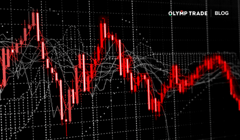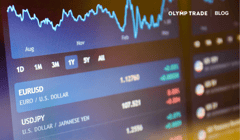
Direct or inverse connections can be formed between different instruments in financial markets. This phenomenon is called correlation and can be used to make trading decisions. When trading on Forex pairs, correlations should be identified and worked into your trading decisions. In this article, we discuss existing market trading systems and methods for finding currency pairs in Forex that have a positive and negative correlation.
Contents:
- Three strategies for market trading
- Base currency and quote currency
- How to use currency pair correlation in trading
- Using currency pair correlations for arbitrage
- Conclusion
Interact with the underlined words and green dots to get additional details and explanations.
Additional context for the visuals.
Explanations and definitions of terms.
Three Forex correlation strategies for market trading
There are three key strategies for trading on absolutely any market:
Directional trading
This refers to strategies based on the investor’s own forecast of either the overall financial market or a particular asset. It involves analyzing market behavior and making a choice about which direction to trade in. For example, if we believe that EUR/USD will continue to decline, we open a Down trade on the pair. With this strategy, the risks are always at a maximum and depend on the quality of the analysis.
Hedging
Instead of focusing on making profits, hedge funds protect against market risks. For example, an American company does business in Europe and makes part of its profit in euros. It is crucial for this company to protect itself against a fall in the euro against the dollar, so it can purchase put options on the EUR/USD pair. If the
EUR/USD later falls, the company’s profits aren’t negatively affected. It’s as if the company has bought insurance in case the currency falls.
Arbitrage
Arbitrage is making risk-free returns in the market because of price inconsistencies across exchanges or bugs in the system, although nowadays it is extremely difficult to profit from pricing errors. An example is when two assets should move in the same direction but are moving in different directions for some reason, traders can make money on the fact that the prices of these assets are bound to converge again at some point. In order to determine whether arbitrage between different assets is possible and to be able to hedge losses, we need correlation.
Correlation is the relationship between two or more variables. If the correlation is strong, then an increase in one quantity will mean that the other quantity will also increase. Examples of assets with a strong correlation are oil and petrol, gold and silver, oil and the stock price of oil companies, etc.
If a correlation is weak, then the dependence of one asset on another is either weak or non-existent. For example, the stock prices of oil producers are unlikely to depend on metal prices.
There is also negative correlation — when the relationship between values is reversed. A striking example of negative correlation on Olymp Trade is the behavior of the NASDAQ index and the
Nasdaq Reversal 2x ETF, which is specifically built to replicate the behavior of the NASDAQ index in reverse, so that contrarian traders can still profit from the decline in an asset class.
Forex currency pairs also have correlations. Let’s take a look at how they work 👀
Base currency and quote currency
You can determine which currency pairs are correlated simply by determining whether they are a base currency or a quote currency. For example, pairs where EUR is the base currency, such as EUR/AUD, must correlate with
EUR/CAD,
EUR/CHF,
EUR/GBP and
EUR/JPY. If the US dollar is used as the quoted currency in the pair
EUR/USD, then
GBP/USD,
AUD/USD and
NZD/USD should all correlate with each other.
Meanwhile, there should be a negative correlation between EUR/USD and, for example,
USD/JPY.
In reality, of course, it’s not quite that simple. The fact is that the price of a currency pair is determined by both the base currency and the quote currency. As a consequence, it is not entirely correct to compare some currency pairs. Let us take the cross rate EUR/CAD and
EUR/CHF as an example. The base currency in both pairs is EUR, but the movements of these pairs are also determined by the Canadian and Swiss currencies, which in their turn depend on the monetary policies of Canada and Switzerland. Switzerland’s monetary policy has traditionally been ultra-conservative, as its key rate rarely changes and has remained in the negative zone for a rather long time. In Canada, on the other hand, the rate is more volatile and depends on the economic situation.

Swiss interest rate
Canadian interest rate
Other cross rates, though, are better to compare. For instance, EUR/CHF and
EUR/JPY, because Japan also has a rather conservative monetary policy.
As for EUR/CAD, it would be more appropriate to compare it with, for instance,
EUR/AUD and
EUR/NZD because monetary policies in Canada, Australia and New Zealand are quite similar.
How to use currency pair correlation in trading
Using currency pair correlation to hedge risk
Let’s assume that we believe the EUR/USD pair will continue to decline during the current trading day. In this case, we can open Down trades on Olymp Trade’s Forex mode. Further, let us assume that according to our money management system, the amount of our trade will be $100 with a multiplier of 200x. This means that the total amount for which we open a trade is $20,000. In accordance with our system, we allow a loss of 25% of the transaction amount, i.e., no more than $25. We can set an appropriate Stop Loss at -$25, or we can spread out this maximum loss and hedge our trade.
Our Stop Loss on Olymp Trade Forex will be set at -$10, which means that if the loss is $10 (or 10% of the trade), the trade will be closed automatically. In order to compensate for this $10 loss, we will open a rebalancing trade in Fixed Time Trades mode on GBP/USD, which will be up for 23 hours. If the rate of return on GBP/USD is 82%, then in order to make $10, we need to open a trade for approximately $13.
The reason for this allocation is that if EUR/USD continues to decline, we will start earning on Olymp Trade Forex. EUR/USD is correlated with
GBP/USD, which means that if
EUR/USD is declining, then
GBP/USD will also be declining. In this case, on Olymp Trade FTT, we will get a loss equal to the amount of our transaction: $13. This loss will reduce our total profit from the transaction on Olymp Trade Forex, but the purpose of hedging is to protect against risks, so we can consider such loss as an insurance fee.
If EUR/USD starts to grow during the day and we start to incur losses in Forex, we will make a profit in FTT, because the growth of
EUR/USD will mean growth of
GBP/USD, which means a profit of 82% of the trade amount or $10. If a Stop Loss is triggered on Forex, the loss on the Forex trade will be fully compensated by the profit on an FTT trade.
Finally, the worst-case scenario for us is if EUR/USD starts growing and a Stop Loss is triggered in Forex. However, we will also lose in FTT, for example, if
GBP/USD falls due to the UK’s poor economic results or any other reason. In that case, our maximum loss would be $23, which fits well with our money management system.
Read more: What is pairs trading?
Using currency pair correlations for arbitrage
Arbitrage is a more sophisticated approach to trading. It involves searching for market errors and bugs that periodically appear on the market. Let us, for example, consider two currencies — EUR/CHF and
EUR/JPY. These currencies must correlate with each other. Pay attention to the chart ⬇️

EUR/JPY
EUR/CHF
There is a very clear correlation between EUR/JPY and
EUR/CHF. If one currency pair is rising, the other is also rising. However, in the past few months, there has been a divergence in the behavior of these cross rates. Specifically, while
EUR/JPY was rising,
EUR/CHF was falling. There is an explanation for this: The Bank of Switzerland decided to raise its key rate, which has resulted in CHF strengthening against other currencies. Meanwhile, we should remember that this divergence in currencies’ behavior is rather an exception than a rule, which means that we can expect the pair to converge again, which will mean either a decrease in
EUR/JPY, an increase in
EUR/CHF or a combination of both. As a consequence, the optimal market behavior in this case is to open a Down deal in
EUR/JPY and at the same time, open an Up deal in
EUR/CHF. Both trades should be opened with obligatory Stop Losses.
Conclusion
Currency pair correlation can be used effectively for trading. Basically, correlation can be used to open hedging trades or to make arbitrage transactions. Now you know the important nuances and strategies that will allow you to use this effective trading tool in the financial markets. Do not forget about implementing sufficient risk management and money management, so that trading on currency correlations can become a worthy tool in your trading arsenal.
Practice your acquired knowledge with Olymp Trade. Our platform makes any trading strategy easy and guides you toward financial success. Become part of the multimillion-strong community of Olymp Trade traders today and become a force to be reckoned with on the markets.
Go to Olymp TradeRisk warning: The contents of this article do not constitute investment advice, and you bear sole responsibility for your trading activity and/or trading results.
A contract allowing the purchaser to sell a specific amount of an asset at a predetermined price within a predetermined timeframe.
Also called the transaction currency, it is the first currency appearing in a currency pair quotation.
The second currency in both a direct and indirect currency pair and is used to determine the value of the base currency.
An exchange between two currencies that are valued against a third currency.
A set of tools used by a nation’s central bank to control the overall money supply, promote economic growth, and employ strategies such as revising interest rates and changing bank reserve requirements.
The specific interest rate that determines bank lending rates and the cost of credit for borrowers.
A postponed order that limits losses on a trade to a specified level.











